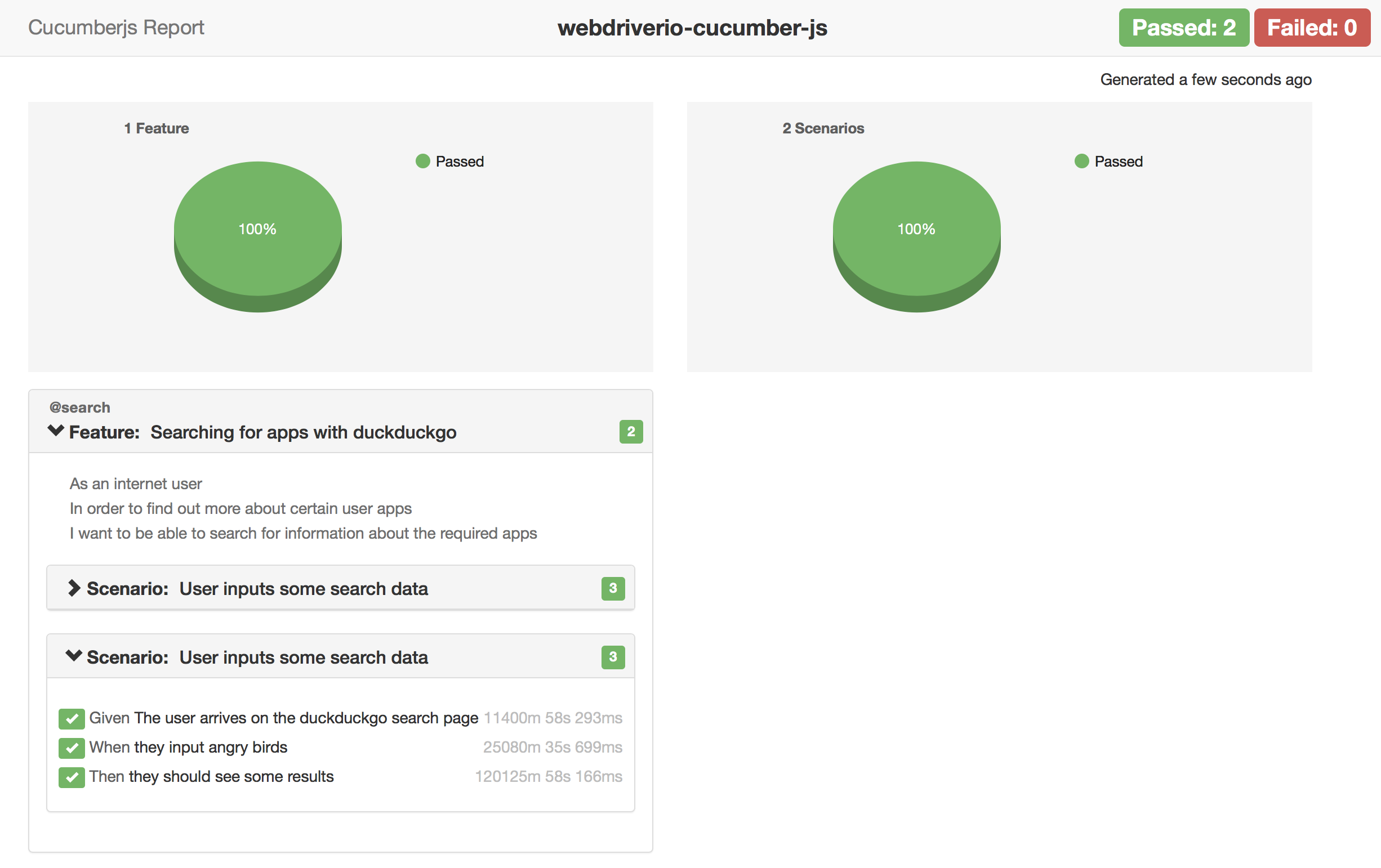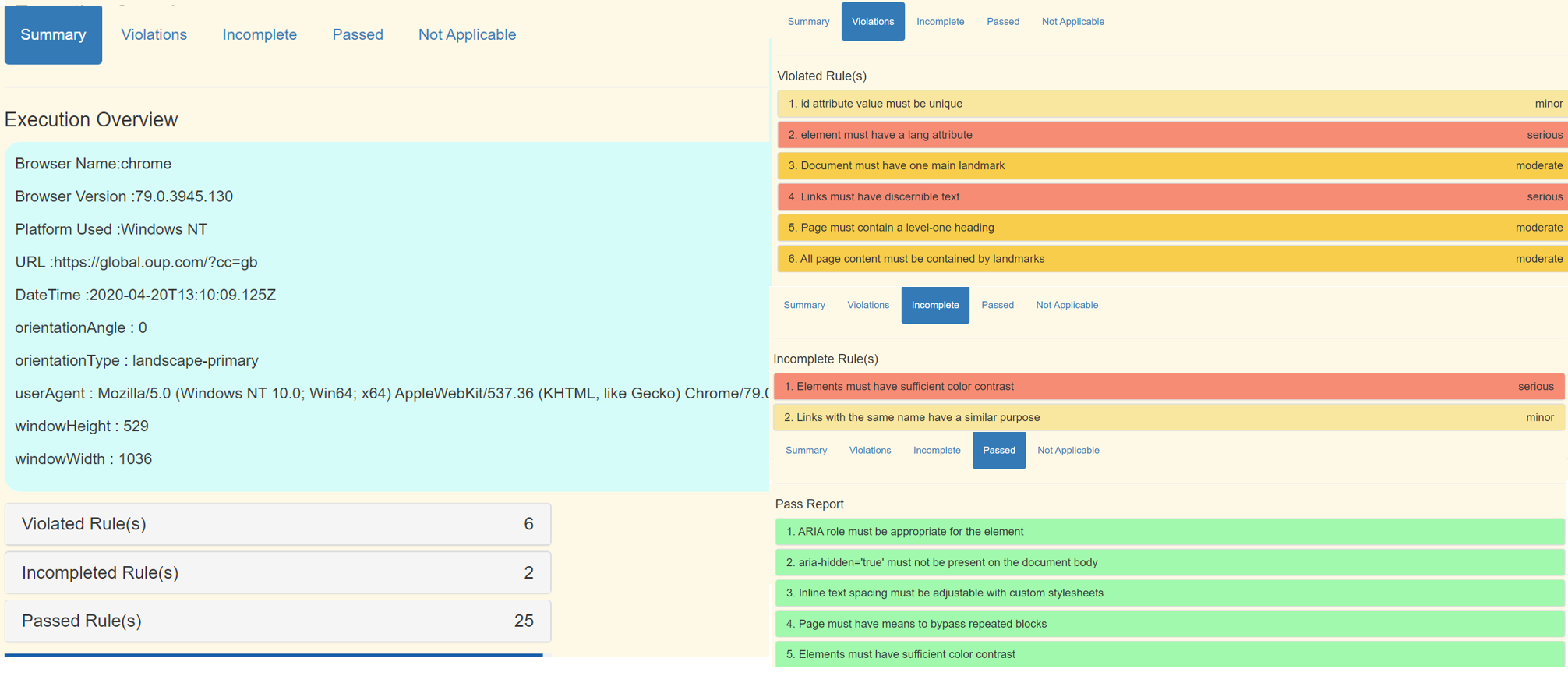


klassi-Js is a debuggable BDD Javascript test automation framework. Built on webdriver.io (Next-gen browser and mobile automation test framework for Node.js) and cucumber-js with integrated Visual, accessibility and API Testing, your test can run locally or in the cloud using Lambdatest, BrowserStack or Sauce Labs
Please check that you have these applications installed on your PC/Mac:
yarn add klassi-js
npm install klassi-jsnode ./node_modules/klassi-js/index.js--help output usage information
--version output the version number
--browser <name> name of browser to use (chrome, firefox). defaults to chrome
--tags <@tagName> name of cucumber tags to run - Multiple TAGS usage (@tag1,@tag2)
--exclude <@tagName> name of cucumber tags to exclude - Multiple TAGS usage(@tag3,@tag5)
--steps <path> path to step definitions. defaults to ./step-definitions
--featureFiles <path> path to feature definitions. defaults to ./features
--pageObjects <path> path to page objects. defaults to ./page-objects
--sharedObjects <paths> path to shared objects - repeatable. defaults to ./shared-objects
--reports <path> output path to save reports. defaults to ./reports
--disableReport disables the test report from opening after test completion
--email sends email reports to stakeholders
--env <path> name of environment to run the framework/test in. default to dev
--reportName <optional> name of what the report would be called i.e. 'Automated Test'
--remoteService <optional> which remote driver service, if any, should be used e.g. browserstack
--extraSettings <optional> further piped configs split with pipes
--updateBaselineImages automatically update the baseline image after a failed comparison or new images
--wdProtocol the switch to change the browser option from using devtools to webdriver
--closeBrowser <optional> this closes the browser after each scenario, defaults to always, use 'no' if you want to want to keep the browser open --closeBrowser no || this leaves the browser open after the session completes, useful when debugging testYou can use the framework without any command line arguments if your application uses the following folder structure, to help with the built in functionality usage, we have added a .envConfigrc.js file at the base of the project which will contain all your env configs . You can check out the working TEMPLATE HERE
.
└── features
└── search.feature
└── page-objects
└── search.js
└── shared-objects
└── searchData.js
└── step_definitions
└── search-steps.js
└── reports # folder and content gets created automatically on test run
└── chrome
├── reportName-01-01-1900-235959.html
└── reportName-01-01-1900-235959.json
.envConfigrc.js # this file will contain all your environment variables #projectName, emailAddresses, environments, browserstack/lambdatest configThe following variables are available within the Given(), When() and Then() functions:
| Variable | Description |
|---|---|
browser |
an instance of webdriverio (the browser) |
wdio |
the raw webdriverio module, providing access to static properties/methods |
pageObjects |
collection of page objects loaded from disk and keyed by filename |
sharedObjects |
collection of shared objects loaded from disk and keyed by filename |
helpers |
a collection of helper methods things webdriver.io does not provide but really should! |
expect |
instance of chai expect to expect('something').to.equal('something') |
assert |
instance of chai assert to assert.isOk('everything', 'everything is ok') |
trace |
handy trace method to log console output with increased visibility |
got |
exposes the GOT subroutine for API testing |
Klassi-js contains a few helper methods to help along the way, these methods are:
// Load a URL, returning only when the <body> tag is present
await helpers.loadPage('https://duckduckgo.com', 10);
// take image for comparisson
await helpers.takeImage('flower_1-0.png', 'div.badge-link--serp.ddg-extension-hide.js-badge-link');
// compare taken image with baseline image
await helpers.compareImage('flower_1-0.png');
// get the content of an endpoint
await helpers.apiCall('http://httpbin.org/get', 'get');
// writing content to a text file
await helpers.writeToTxtFile(filepath, output);
// reading content froma text file
await helpers.readFromFile(filepath);
// applying the current date to files
await helpers.currentDate();
// get current date and time (dd-mm-yyyy-00:00:00)
await helpers.getCurrentDateTime()
// clicks an element (or multiple if present) that is not visible, useful in situations where a menu needs a hover before a child link appears
await helpers.clickHiddenElement(selector, textToMatch)
// This method is useful for dropdown boxes as some of them have default 'Please select' option on index 0
await helpers.getRandomIntegerExcludeFirst(range)
// Get the href link from an element
await helpers.getLink(selector)
//wait until and element is visible and click it
await helpers.waitAndClick(selector)
// wait until element to be in focus and set the value
await helpers.waitAndSetValue(selector, value)
// function to get element from frame or frameset
await helpers.getElementFromFrame(frameName, selector)
// This will assert 'equal' text being returned
await helpers.assertText(selector, expected)
// This will assert text being returned includes
await helpers.expectToIncludeText(selector, expectedText)
// this asserts that the returned url is the correct one
await helpers.assertUrl(expected)By default, the test run using Google Chrome/devtools protocol, to run tests using another browser locally you'll need a local selenium server running, supply the browser name along with the --wdProtocol --browser switch
| Browser | Example |
|---|---|
| Chrome | --wdProtocol --browser chrome |
| Firefox | --wdProtocol --browser firefox |
All other browser configurations are available via 3rd party services (i.e. browserstack | lambdatest)
Selenium Standalone Server installation
npm install -g selenium-standalone@latest
selenium-standalone install
selenium-standalone startVisual Regression with Resemble JS
Visual regression testing, the ability to compare a whole page screenshots or of specific parts of the application / page under test. If there is dynamic content (i.e. a clock), hide this element by passing the selector (or an array of selectors) to the takeImage function.
// usage within page-object file:
await helpers.takeImage(fileName, [elementsToHide, elementsToHide]);
await browser.pause(100);
await helpers.compareImage(fileName);API Testing with PactumJS
Getting data from a JSON REST API
apiCall: async (url, method, auth, body, status) => {
let resp;
const options = {
url,
method,
headers: {
Authorization: `Bearer ${auth}`,
'content-Type': 'application/json',
},
body,
};
if (method === 'GET') {
resp = await helpers.apiCall(url, 'GET', auth);
return resp.statusCode;
}
if (method === 'POST') {
resp = await helpers.apiCall(url, 'POST', auth, body, status);
return resp;
}
}Accessibility Testing with Axe
Automated accessibility testing feature has been introduced using the Axe-Core OpenSource library.
All the accessibility fuctions can be accessed through the global variable accessibilityLib.
| function | Description |
|---|---|
accessibilityLib.getAccessibilityReport('PageName') |
generates the accessibility report with the given page name |
accessibilityLib.getAccessibilityError() |
returns the total number of error count for a particular page. |
accessibilityLib.getAccessibilityTotalError() |
returns the total number of error count for all the pages in a particilar execution |
// usage within page-object file:
When('I run the accesibility analysis for {string}', async function (PageName) {
// After navigating to a particular page, just call the function to generate the accessibility report
await accessibilityLib.getAccessibilityReport(PageName);
});
Then('there should not be any violation in the accessibility report', function () {
// This will return the total accessibility error count for a particular page.
let violationcount=accessibilityLib.getAccessibilityError();
assert.equal(violationcount, 0);
});HTML and JSON reports will be automatically generated and stored in the default ./reports folder. This location can be
changed by providing a new path using the --reports command line switch:
HTML and JSON reports will be automatically generated and stored in the default ./reports/accessibility folder.This location can be changed by providing a new path using the --reports command line switch:
You can register event handlers for the following events within the cucumber lifecycle.
const {After, Before, AfterAll, BeforeAll, BeforeStep, AfterStep} = require('@cucumber/cucumber');
| Event | Example |
|---|---|
| Before | Before(function() { // This hook will be executed before all scenarios}) |
| After | After(function() {// This hook will be executed after all scenarios}); |
| BeforeAll | BeforeAll(function() {// perform some shared setup}); |
| AfterAll | AfterAll(function() {// perform some shared teardown}); |
| BeforeStep | BeforeStep(function() {// This hook will be executed before all steps in a scenario with tagname; |
| AfterStep | AfterStep(function() {// This hook will be executed after all steps, and take a screenshot on step failure; |
Most webdriverio methods return a JavaScript Promise that is resolved when the method completes. The easiest way to step in with a debugger is to add a .then method to the function and place a debugger statement within it, for example:
When(/^I search DuckDuckGo for "([^"]*)"$/, function (searchQuery, done) {
elem = browser.$('#search_form_input_homepage').then(function(input) {
expect(input).to.exist;
debugger; // <<- your IDE should step in at this point, with the browser open
return input;
})
done(); // <<- let cucumber know you're done
});To demo the framework without installing it into your project use the following commands:
# download this example code
git clone https://github.com/larryg01/klassi-js.git
# browser to the new directory
cd klassi-js
# run the search feature
yarn install
node index.js --tags @searchPlease raise bugs via the klassi-js issue tracker, please provide enough information for bug reproduction.
Anyone can contribute to this project, PRs are welcome. In lieu of a formal styleguide, please take care to maintain the existing coding style.
Licenced under MIT License © 2016 Larry Goddard


